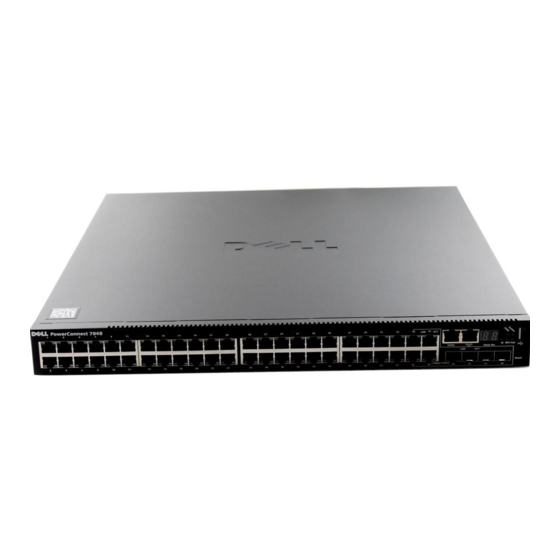
Dell PowerConnect 7048P Manuals
Manuals and User Guides for Dell PowerConnect 7048P. We have 5 Dell PowerConnect 7048P manuals available for free PDF download: Manual, Getting Started Manual, Release Note, Release Notes, Upgrading Firmware
Dell PowerConnect 7048P Manual (1234 pages)
PowerConnect 7000 Series Stackable Layer 2 and 3 switches
Table of Contents
-
-
-
Log Messages52
-
Sflow55
-
-
Ssh/Ssl59
-
-
Voice VLAN69
-
Guest VLAN69
-
Double Vlans69
-
-
VLAN Routing72
-
-
Ipv6 Routes75
-
-
IGMP Proxy79
-
-
-
-
Port Leds91
-
Module Leds93
-
System Leds95
-
-
-
-
-
-
-
-
-
Stack Summary148
-
NSF Summary153
-
-
-
-
-
Access Profile180
-
Line Password194
-
Enable Password194
-
TACACS+ Settings195
-
Telnet Server205
-
-
-
-
-
Information235
-
-
System Health242
-
System Resources243
-
RAM Log249
-
Log File250
-
-
-
-
-
CLI Banner281
-
Clock283
-
SNTP Server287
-
Slot Summary294
-
Supported Cards295
-
-
SNMP Overview313
-
What Is SNMP313
-
-
-
Communities324
-
Trap Flags331
-
Trap Log334
-
-
-
-
-
File System356
-
Active Images357
-
USB Flash Drive358
-
File Download359
-
File Upload361
-
Copy Files363
-
-
-
-
-
-
-
GVRP Statistics403
-
EAP Statistics404
-
Counter Summary406
-
RMON Statistics408
-
RMON Event Log414
-
RMON Alarms415
-
Port Statistics417
-
LAG Statistics418
-
Port Mirroring419
-
-
Configuring RMON429
-
-
-
-
-
Local User458
-
User Group462
-
Client Summary469
-
Client Detail470
-
-
Port Overview483
-
-
-
-
Security505
-
-
Port Security520
-
-
-
-
ACL Overview539
-
-
-
VLAN Overview571
-
Switchport Modes574
-
VLAN Tagging575
-
Gvrp576
-
Voice VLAN577
-
-
-
Creating a VLAN602
-
Configuring GVRP612
-
-
-
-
Protocol629
-
STP Overview629
-
-
STP LAG Settings642
-
MSTP Settings645
-
-
Configuring STP654
-
Configuring MSTP656
-
-
-
-
-
-
What Is ISDP659
-
-
What Is LLDP659
-
What Is LLDP-MED660
-
-
ISDP Cache Table664
-
ISDP Statistics667
-
LLDP Statistics670
-
LLDP Connections671
-
-
Configuring ISDP683
-
Configuring LLDP684
-
-
Advertisement
Dell PowerConnect 7048P Getting Started Manual (402 pages)
PowerConnect 7000 Series
Table of Contents
-
Switch Ports11
-
Console Port11
-
USB Port12
-
Reset Button12
-
Locator LED15
-
Installation16
-
Next Steps31
-
硬件概览38
-
Usb42
-
Led42
-
Led45
-
簡介69
-
硬體概覽70
-
Usb74
-
Led74
-
Led77
-
Installation110
-
Montage En Rack112
-
Mot De Passe126
-
Einführung135
-
Switch-Ports139
-
Konsolen-Port140
-
USB-Port140
-
Reset-Taste140
-
Netzteile143
-
Belüftungssystem144
-
Standort-LED144
-
Installation144
-
Auspacken145
-
Des Switches150
-
Beispiel-Ablauf156
-
Nächste Schritte163
-
Pendahuluan169
-
Port Switch173
-
Port Konsol174
-
Port USB175
-
Tombol Reset175
-
Catu Daya177
-
Sistem Ventilasi178
-
LED Lokasi178
-
Instalasi179
-
Penyiapan Lokasi179
-
Isi Kemasan179
-
Memasang Switch180
-
Booting Switch189
-
Contoh Sesi191
-
はじめに205
-
ハードウェアの概要206
-
Led209
-
Usb210
-
Led Led211
-
하드웨어 개요240
Dell PowerConnect 7048P Release Note (74 pages)
5.1.0.1 Firmware Release Notes
Table of Contents
-
Known Issues60
Advertisement
Dell PowerConnect 7048P Release Notes (27 pages)
System Firmware Version 4.1.0.6
Table of Contents
-
Layer 225
Dell PowerConnect 7048P Upgrading Firmware (24 pages)
Upgrading from Version 2.x.x.x or 3.x.x.x or 4.x.x.x or 5.x.x.x to 5.1.9.3 Firmware
Table of Contents
Advertisement




